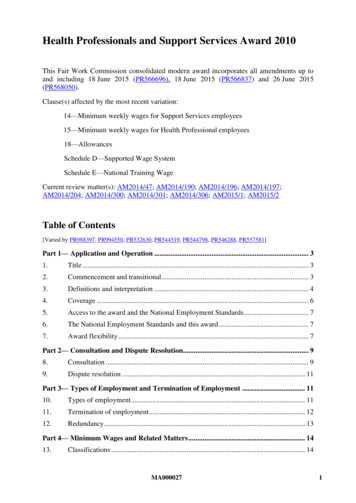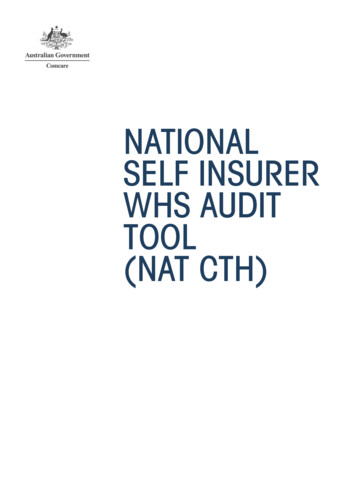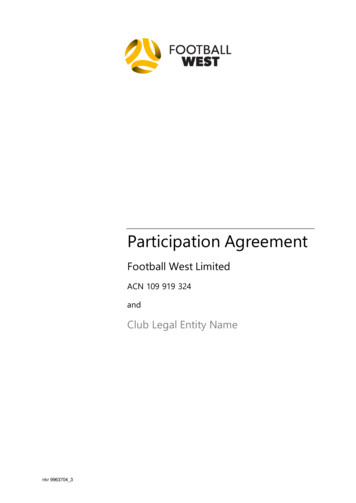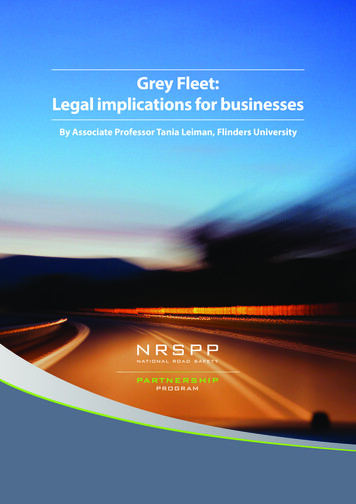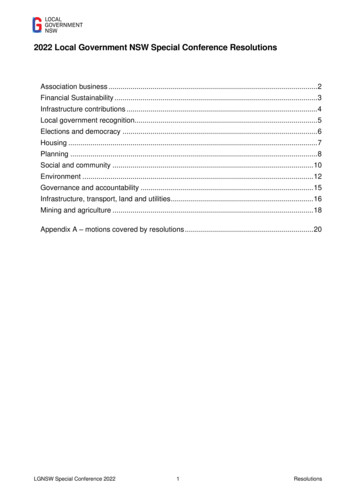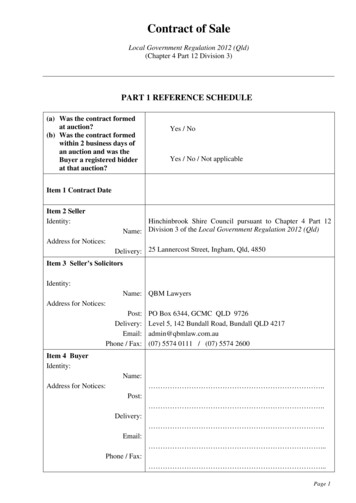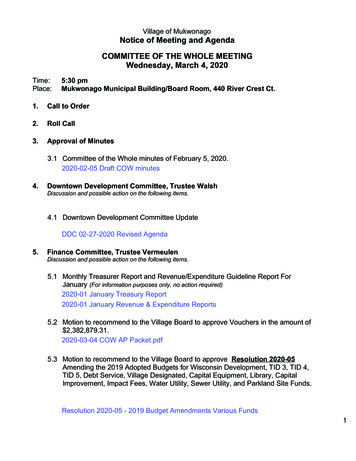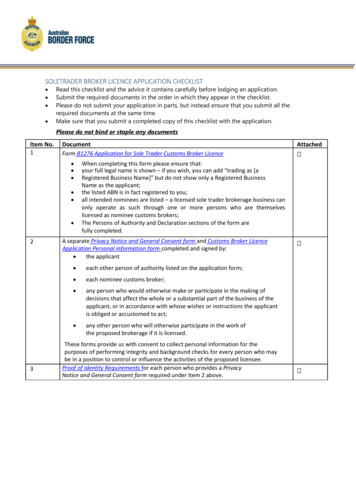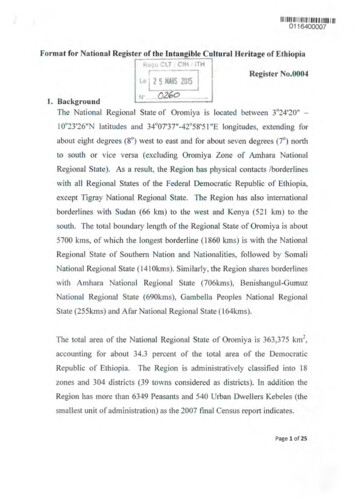
Transcription
Ill Jill IIIII 111111111 IIIII III0116400007Format for National Register of the Intangible Cultu ral Heritage of EthiopiarMt;; L . LTLer-CtHiTH. 14ARS 201 N" . .Register No.000402fJ.9 . .1. BackgroundThe National Regional State of Oromiya is located between 3 24'20" 10 23'26"N latitudes and 34 07'37"-42 58'5 1"E longitudes, extending forabout eight degrees (8 ) west to east and for about seven degrees (7 ) northto south or vice versa (excluding Oromiya Zone of Amhara NationalRegional State). As a result, the Region has physical contacts /borderlineswith all Regional States of the Federal Democratic Republic of Ethiopia,except Tigray National Regional State. The Region has also internationalborderlines with Sudan (66 km) to the west and Kenya (521 km) to thesouth. The total boundary length of the Regional State of Oromiya is about5700 kms, of which the longest borderline (1860 kms) is with the NationalRegional State of Southern Nation and Nationalities, followed by SomaliNational Regional State ( 141 Okms ). Similarly, the Region shares borderlineswith Amhara National Regional State (706kms), Benishangul-GumuzNational Regional State (690kms ), Gam bella Peoples National RegionalState (255kms) and Afar National Regional State ( 164kms).The total area of the National Regional State of Oromiya is 363,375 km 2 ,accounting for about 34.3 percent of the total area of the DemocraticRepublic of Ethiopia.The Region is administratively classified into 18zones and 304 districts (39 towns considered as districts). In addition theRegion has more than 6349 Peasants and 540 Urban Dwellers Kebeles (thesmallest unit of administration) as the 2007 final Census report indicates.Page 1 of 25
The total population of the region is estimated to be more than 30 million which isabout 37% ofthe total population of Ethiopia. The capital ofthe region is Finfinneor Addis Ababa.The Oromo people, like the other peoples and nationalities of the country, haveimmense tangible and intangible heritages which have been created over centuriesin the interactions of the people with natural and social environments and whichstand as the manifestations of the identity of the people. This inventory is relatedto one of these intangible heritages that is the Gada system of administration. Theinventory is conducted with regard to the Oromo of Borana, Guji,Gabra, Karrayu,lttu, Humbana, Tulema and Macha who have always been practicing the Gadasystem to this date.2. Information on the Intangible Heritage2.1 DomainSocial practices, rituals and festive events: Performing Art; knowledge andpractices concerning nature and the universe; oral traditions and expressiOns,including language as a vehicle of the intangible cultural heritage.2.2Name of the Element (as used by the community or groupconcerned)Sirna Gadaa:Sirna Hawaas-Siyaasaa Dimokraatawaa Ummata OromooThese include the Borana, Guji Gabra,Karrayu, Tulema, Macha, lttu and Humbanaclans of the Oromo Nation.2J
2.3 Description of the ElementThe Gada system is an extensive and complex system consisting of numerousinstitutions and structures, inextricably linked with the existence and growth of theOromo people holistically and, when compared with the other systems among theother Cushitic peoples, it is a traditional system of governance which has growngradually from ingenuousness to complexity and all-roundedness. In short, theGada system is a system which includes many institutions and which incorporatesthe social, political, economic and religious systems of the Oromo people.Though nothing is really known as yet as to how and when this system was started,there are historical evidences which indicate that the people of Oromo have beengoverned according to the Gada system for a very long period of time. In thesehistorical documents, it was stated that the Gada system was practiced with all itssophistication in early 16111 century.Before proceeding to the organization and structures of the Gada system, it wouldbe impmtant to indicate certain things about the word Gada. The word Gada hasbeen used to mean many things and it represents more than one concepts. Firstly,Gada is a system of timekeeping or calendar. It is also the name of the sixthhierarchy in the system known as Gada that is the group on power. Thirdly, theterm has also been used to refer to the 8-years cycle in which each level stays onpower. Fourthly, Gada stands to signify the whole system. Gada is a traditionalsystem of governance in which the core cultural aspects of the Oromo people andindigenous knowledge and wisdom are reflected.The Gada system is a traditional ways of govetnance which guides the overallaspects of the social, political, economic, and religious lives of the Oromo peoplewho have been upholding it for long period of time. It is a core feature of thePage 3 of 25
identity of the Oromo people which has been practiced for centuries and is still inpractice among the Oromo.Among the Oromo people, the Gada System is an intangible heritage which cansurely be taken as an exemplary system in which the male members of the nationare organized into five hierarchies or grades based not on age but rather ongenealogical generation or descent. In each respective stage, they are educated andtrained to fulfill their social obligations and attain to physical and mental maturityand at the sixth stage, they assume the responsibility of providing all-roundedleadership to the lives of the people. Finally, at the end of the gthyear, they handover power to the next generation in a democratic way. The main and foremostobjective of the Gada system is to produce in groups, or in cohorts citizens who areable and competent enough to fulfill their duties and responsibilities in the society.Any male member of the Oromo is incorporated into as a member in one of thesocial stratum which is based on generation starting right from birth. Cohorts in aGada stratum celebrate their transition to next stratum together. A person who is amember of his cohort remains member of the same cohort until he retires from allthe Gada strata.The naming of the five classes in Gada system (Gogessa) varies from place toplace. The Oromo of Borana is one of the communities among whom the Gadasystem has remained intact; and, in this locality the people name these classes as:Fullas, Derw-a, Makulla, Moggisa, and Sabaka. The five major classes among theGuji Oromo who take power in every eight-years cycle refer to these as: Mudana,Dhalana, Robale, Harmufa, and Halchisa while the Karayyu refer to them asRobale (IImaMogisa), Birmaji (IImaSabaka), melba (IImaNikusa), Michile orDilbo (llmaMamara), and Halachis or Dullo (lima Darara).Page 4 of25
On the other hand, the Tulema and Macha Oromo refer to the five classes as:Birmaji, Horeta, Dullo, Michile and Robale; and, among the lttu, they are knownas: Horeta, Sabaka, Badhadha, Darara and Fadata.In the Gada system, there is a gap of forty years between a father and his son.According to the basic custom of the system, a son is admitted to Gada system, onthe 40th year after the father joined the system. All male children born to fatherswho are on power form a cohort which is the first grade and known as Dabale.There is a gap of eight years between each successive grade and children who areup to 8 years old become members of the first grade, i. e., Dabale. Members of thisgrade are identified with the style of their hair which is called Guduru and theydecorate their hair with cowry shell (Zagol). On their 81h year, a ceremony isorganized to give them names officially and they pass to the second grade knownas Gamme Titiko (meaning 'the little Gammes). These toddlers stay in this gradefor the period from their 9th until they are 16 years old. During this period, they gettheir hair shaved in circular shape in the center of their head leaving the hair on thesurrounding part unshaved. There is no ceremony to announce their transition tothe third grade and those who are in the third grade or stratum are different fromthose in the second grade just with the width of the circle on their head which theyget shaved. The members of the third grade or stratum are known as GammeGurgudo (meaning 'the bigger Gammes ). Their age is between 17 - 24 years.Members of this grade have the duty of leading the cattle of their fam ilies awayfrom home to remote areas in search of pasture and water. In this process, they areexpected to grow stronger physically and become more self-reliant and confident.The cohmts of the 4th grade are refeiTed to as Kusa and they are between 25 - 32years old. Six members of the Kusa stratum are recruited and conditions arefacilitated for them to acquire leadership knowledge and skills. These recruits formPage 5 of 25
a group known as the Adula Council. In addition, assistants known as Jalaba areappointed to help these recruits.The members of the fifth grade or stratum are known as Raba Dori and they arebetween 33- 40 years old. This is the stage at which the members get married andestablish their own families. At the end of the fifth grade, members of Raba Dorimake preparations to take up the role of administration. For instance, among theKarrayu Oromo, there is a system in which the Raba Dori acquires enoughexperience from those who are in power by sharing responsibilities or bydelegating some power to the latter. The6thgrade or stratum is known as Gada andthe age of the members is between 41-48 years. Members of the Gada stratum arethose who are in power and render political administrative functions to the people.In the Gada System, political power is held by members of Gada Grade.Nevertheless, members of the Gada stratum elect from among themselvesexecutive members who govern the people by assuming political power. In theelection process, the first election is made to identify a member who has to take upthe supreme power, that is, Abba Gada or Abba Boku. The handover is effected byorganizing formal ceremony in which the outgoing Abba Gada/Abba Boku handsan Ostrich feather known as Bali to the elect Abba Gada as a symbol of politicalpower. Then the outgoing Abba Gada passes, along with the members of his grade,to the next grade or stratum known as Yuba. The members of the stratum whichassumed power stays in power for the next eight years. This cohort issuesproclamations and promulgates statutes and also renders spiritual leadership onGada ceremonies and festivities. In the Gada System, the four grades following theGada stratum are known as Yuba 1, Yuba 2, Yuba 3 and Yuba 4. The age ofmembers of this grade is from 49 to 80. Members of the earlier Gada grade whowere in power now assume the roles of advisory to the incumbent rulers andPage 6 of 25
interpreting the laws. Members of the final stratum, grade 11 are known asGadamoji and those who complete this stage retire from the system and they arecalled Jarsa and remain so till their death.The Gada System has a number of institutions and procedures of conflictresolution, mechanisms of dealing with social and political matters. For instance,Guma is an institution of conflict resolution in which a person who has inflictedloss or damage compensates the victim. Similarly, the Mogasa system is a systemin which any person or group who willfully decide to become a member of theOromo would be granted such privilege. Such person would then have equal rights(political, social, economic, etc.) with any person who is an Oromo by birth.The other institution which was created within the Gada System is what is knownas Siinqee and this institution has the role of making sure that the rights of womenare duly respected. The word siinqee signifies a thin stick which is given to anOromo woman on her wedding day by her mother. Siinqee is an instrument toensure the protection of women's rights and whenever these rights are transgressedor violated, women rally for demonstration canying their Siinqee to demand thattheir rights should be respected. The Gada System is a democratic system in whichrule of law is duly abide with. Moreover, there is task of promulgating statutes andamending those which are found untenable once every eight years. In the GadaSystem, there are three governmental bodies: the executive, the judiciary and thelegislative which have been put into practice to minimize abuse of power. TheGada System also includes the Irrecha ceremony which is organized twice a yearas thanksgiving event to Waqa, the Supreme Being believed in among the Oromo.It is especially celebrated at national level at the end of the month of September atBishoftu town on Hora (Lake) Arsadi. The event is presided over by the AbbaGada and the participants take with them a bunch of green grass and Adey AbabaPage 7 of 25
flower or Ada (Abisinian Daises) to be placed on the shore of the lake whilechanting the thanks to Waqa for helping them pass over to the bright spring seasonfrom the dark season of rainy summer.Irrecha Festival at HoraArsadi2.4 Significance of the Intangible Cultural HeritageBeing a heritage that provides the Oromo with a sense of identity and continuity,the Gada System is the most important heritage and it has multi-purpose to thepeople. The system provides guidance to the political, social, economic andspiritual aspects of the lives of the Oromo people. It also enables resolve conflictsand ensures peace and stability and regulates the day-to-day lives of the people. Inthis process, side by side with being abide by the customs they have inherited fromtheir ancestors, they make sure that those rules and customs which are found to bePage 8 of25
unfit in light of the social, political, economic and spiritual realities of the peopleare amended and new laws are issued and enforced.Furthermore, it hasconsiderable significance in ensuring the solidarity of the people. In addition, thepractitioners and performers make sure that the differences and disagreementswhich arise among the Oromo people themselves and between the Oromo peopleand neighboring ethnic groups are resolved in accordance with the rules set inplace. During the years when they stay in the system, they devote their full time toensuring the values and customs they inherited from their ancestors which are dulyrespected and practiced among the wider society. To this end, they attend differentceremonies and festivals and strengthen the spiritual and psychological unity andsolidarity of the people. Whenever there is drought or scarcity of rainfall, they prayto Waqa for rain and perform different events to make sure that the problem isaverted. They pray and bless that the people live peacefully, the children born tothe people grow up healthy and the sick get better as well as the harvest becomegood. In this way, they build the spiritual and psychological stability of the people.On the other hand, they also work to ensure that natural resources (water holes,grazing fields, etc.) are protected and utilized sustainably; the rules and customsare respected and observed among the community. Therefore, the Gada system is aholistic system which has always been indispensable to the survival of the people.In general, the Gada system has the significance of enabling strong and sustainableties among generations and it has been serving in contributing to the effmts madeto ensure that the Oromo people live harmoniously and peacefully with otherpeoples and nationalities.Page 9 of 25
3. Characteristics of the Element3.1 Associated Tangible AspectsThe Gada system of Oromo people has different tangible aspects. Among thesetangible aspects the Oda tree is the prime one. In Oromo culture, Oda tree servesas political and religious center and to this date, it has immense symbolicsignificance to the members of the nation. With the understanding of thecomprehensive significance of oda tree, the national regional government ofOromia is using Oda as the emblem of the regional government.Oda was selected as a center to organize meetings not just because of its grace andshade. Rather, as told by Oromo elders, what makes Oda preferred to other treespecies is its perennial nature throughout the year without dropping its leaves andbecause it is taken as a symbol of the hope of the people and the ever-greenenvironment of the country.Page 10 of25
A conference held under the OdaBultum to promulgate statutes andrepresentatives of the Oromo people and other ethnic groups during thetransfer of power held on February 5, 2015.Accordingly, even though there were many Oda trees, currently, there are five ofthem which are widely recognized as such. These are: Oda Roba in southernOromia, Oda Nabe in central and Northern Oromia, Oda Bisil and Buluk inwestern Oromia, and Oda Bultum in eastern Oromia. On the other hand, there are anumber of rivers, lakes and mountains where the Oromo people celebrate thethanks giving event ofIrrecha. Among these, Hora Arsadi is the prime onewhich is the cultural center of the heritage.The other tangible aspect of the Gada system is what is known as Kallecha whichis a scepter of power and sovereignty which is borne reverently by the Abba GadaPage 11 of25
on their forehead. According to the custom, bearing Kallecha and going to anunseemly places or spending the night in such places is strictly prohibited. A longstick known as Harara, which the Abba Gada of Borana carry and Baku, which iscarried by the Oromo of Guj i are typical tangible aspects of the heritage andsymbols of power believed to be handed by Waqa.One of the other tangible aspects of the heritage is what is known as Dibayu, astick which is made up of Waanza (cardia) tree and carried by the Abba Baku ofthe Karrayu Oromo and members of Karrayu clan who are married as well as bythe Ittu clan in the western Hararghe during festivals and events. In addition, themembers of Borana clan in the Raba Dari grade prepare a stick known as Danisa(a name it is given after the tree species it is made of) which they require to havebefore bearing children. In the same manner, among the Guji, those who are in thestratum known as Dari have to prepare a stick from cardia tree called Wadesa.Licha (whiplash) is a tangible aspect of the heritage and the Abba Gada carryLicha during the festive of Gumi Gaya, which is an assembly held every eightyears to promulgate laws. Moreover, Licha is also carried by the Hayyu and theheads of households in Borana. The other tangible aspect of the Gada system iswhat is called Rufan a S adeta among the Borana and Mereta among the GujiOromo is a piece of cloth worn on head by the Abba Gada, the Kallu (religiousleader) and other male members of the clans.Among the tangible aspects related to the Gada among the Karrayu are: a red pieceof cloth known as Faji which is flagged at the place where Baku is placed and a redcloth which Abba Baku and his wife wear. Other tangible aspects include trousersto be worn by Abba Gada of the Guji and their assistants known as ganfa and theshorts (hida) which the Abba Gada of the Borana wears, and Teresa, that is wornalong with Hida. Fmihermore, there is a piece of cloth known as Sabata which thePage 12 of 25
Oromo of Karrayu wrap up a newly prepared Baku. The other tangible aspect ofthe heritage is a hom known as Geri which is used by the Karrayu, Borana and theIttu during the handover of power and, as musical instrument, in singing anddancing. Erbora is a kind of bracelet which is made up of ivory and worn by theAbba Gada on their arms; on the other hand, Hirmura is bracelets of iron whichthe Abba Gada of the Guj i Oromo wear on their wrists.The Guji Mati Gada Ruling C1ass that wi11 handover power to the incoming dassafter a few monthsBali or Balguda is a feather of an Ostrich and it is an important tangible aspect ofthe heritage for it is considered as an emblematic stuff or scepter of power duringthe handover of power every eight years. This ceremony of handover of power isknown as Bali Walirafudhu. Dibe (drum) and Magalati (a cultural stuff similar to abig drum) are the other tangible aspects of the heritage which are used by thePage 13 of25
Gabra Oromo during the handover of power. Still another tangible aspect that isrelated to the Gada system is Kumbi (incense) which is offered as a gift during theMuda festival that is when they go to the castle of the Kallu for spiritual purposes.Among the Borana Oromo, the transition from Gadamoji to Jarsa is referred to asKumbi walirafudhu.The other tangible element we find in the Gada system among the Borana Oromois what they refer to it as Gorfo. This is a stuff made up of goat's skin of cow andworn as skirts by the wives of the Abba Gada and Adula. It is produced bybeautifying it with a stripe of leather decorated with cowry shell. Gulma is a jewelmade up of bronze which the wives of Abba Gada of the Borana wear on theirheads as hair decoration and it also symbolizes that these women are the mothersof the Dabale. A typical stuff carried by the Oromo women, the stick known asSiinqee/Sinqe is the other tangible aspect of this heritage. Women carry Siinqeeduring the Irrecha festival along with green grass, wild flowers, and Chachu(cowry shell sawn on the skin of cow). Moreover, this stuff is carried by theOromo women when they go out to demand justice for any misdeed perpetratedagainst them. Furthermore, they use the stick to calm down a fight by going inbetween concerned parties carrying Siinqee. The other tangible element of theheritage is what is known as Saqqa which is a bracelet worn by the wives of theAbba Gada and the Hayyu or the executives.Page 14 of25
Photo: Mothers of the Debele carrying Siinqee.Still another tangible element of the heritage is the stuff which the Kallu andKallitti, who are leaders of the Waqefana religion of the Oromo, wear on theirwrists a precious stuff known as Ledu. It is believed that Ledu was created alongwith Kallu and other people are not allowed to see it. Ledu is a symbolic itemwhich is transferred in accordance with the Kallu tradition to a son when his fatherdies. Buren is a stuff made up of beads and worn by the wives of the Kallu of theBm·ana (Kallitti), the Abba Gada, and the Hayyu on their neck with threads; andDibbe is a small drum that is closely related to the Kallu institution and it isanother tangible aspect of the heritage.Page 15 of 25
3.2Associated Inta ngible AspectsThe Gada system includes numerous cultural events and it has a number ofintangible aspects. The lrrecha ceremony in which the Oromo people express theirgratitude to the Supreme Being by placing a bunch of green grass and anindigenous flower Known as Ada (Adey Ababa) on the shores of lakes and rivers asthanksgiving to Waqa for helping them pass over to the bright spring season fromthe rainy dark summer season, are some of intangible aspects of the heritage.On the other hand, the toddlers at the stage of Dabale let their Guduru hair growand when they pass to the next grade or stratum of Gamme Titiko, they get theirhair shaved and the fact that they get their hair shaved signifies their transition toGamme Gurgudo from Gamme Titiko. At the grade of Dori, before they bearchildren, the ceremony of cutting Danisa tree can all be mentioned as intangibleaspects of the heritage.On the other hand, during the ceremony of power transfer among the Borana andGuji Oromos, the picking of Ostrich feather from the outgoing Abba Gada andplacing it on the newly elected Abba Gada, the ceremony in which members of thenewly elected rulers are provided with yoghurt to drink before the officialhandover of power, the good wishes and prayers made by the Abba Gada, etc., areall the intangible aspects of the heritage.Page 16 of 25
4. Individuals and Institutions that are participants in the inventorying4.1Practitioners/PerformersThe Gada system is one of the mam intangible heritages which are themanifestation of the identity of the Oromo people. Members of the ethnic groupparticipate in the system in different ways. As the Gada system includes differentcommunity groups on different grades there are numerous practitioners andperforms of the heritages. On the other hand, through the roles and extent ofparticipation of the performers vary, all the members of the grades starting fromthe bigger Gamme, Kusa, Raba,-Dori, and the Gada in the6thgrade as well as theother practitioners, women, mothers of the Dabale have their own roles to play inpracticing the heritage. In addition, clan leaders, leaders of the Wakefana faith orthe Kallu, and the counselors and law interpreters or the Yuba as well as the Jalaba(deputy counselors) and Adula Hayyu (senior counselors) are the forefrontpractitioners and performers.4.2Other Participants/Custodians/HoldersIn relation to the Gada system of the Oromo, the other participants are Argadhagetti who have acquired extensive knowledge of history from what they haveseen and heard and from their experience in passing through the system and, whoteach to the youth about the system. At institutional level, the Authority forResearch and Conservation of Cultural Heritage, the Culture and Tourism Bureauof Oromia National Regional Government, and the Offices in the sector at zoneand district or Woreda levels as well as the recently established Council of theAbba Gada are the other participants and custodians of the heritage or the system.Page 17 of 25
4.3Customary Practices Governing Access to the Element or to anyAspect of the ElementEven though the Gada system of the Oromo people is very complex, there is norestriction to observe the social events and ceremonies that are organized mrelation to Gada system and to learn about the system in different ways.The ceremony of transition from one grade or stratum to the next among theBm·ana and, the ceremony of handover of power among the Guji, Karayu and IttuOromos are organized publicly and openly. Therefore, there is no requirement thathas to be fulfilled to observe or attend in these ceremonies. Similarly, among theGabra Oromo clan, though the system is performed openly, the outgoing and thenewly elected have a message they secretly exchange before the ceremony.Fmthermore, there is a mechanism set in place in which the members of thedifferent grades or strata can learn about the system among the Borana as well asthe Guji Oromo by pat1icipating in the law making assemblies that are held once inevery eight years.5. Status of the Element5.1Current State of the ElementThe Gada system is a cultural intangible heritage that is still practiced by differentclans of the Oro mo. The system categorizes the generation into different grades orstrata in accordance with the early legacy. For these groups of the generationwhich are categorized into different grades, the ceremony in which they pass on tonext grade is organized and celebrated. The performers of the system in differentgrades still provide spiritual, psychological and social services to the society. TheAbba Gada and other members of the executive body still practice administrativeroles among the communities. They resolve conflicts in accordance with the lawsPage 18 of 25
proclaimed every eight years. Moreover, they make sure that disagreements andconflicts which may arise among the different Oromo clans and between theOromo and other ethnic groups are promptly resolved; and, peace and stability ismaintained among the society. Furthermore, relentless efforts are being made bythe communities as well as the governmental bodies to ensure the resurgence of thesystem in localities where it has been exposed to different internal and externalinfluences which have been affecting it negatively.Presently, side by side with the extensive efforts being underway to make sure thatthe Gada system revives in different areas, including in areas where it has beenweakened, there are also various challenges to these efforts. Among thesechallenges are the increasing number of population, utilization of the culturalcenters or Arda Jilla for other purposes due to the expansion of farmland andurbanization.5.2Mode of Transmission from Generation to GenerationIn the areas where the Gada system is widely practiced: Borana, Guji, Gabra,Karayu, lttu, Humba, Macha and Tulama Oromo clans, the heritage is beinghanded down from generation to generation in different ways. Among thesemechanisms is the transition from one grade or stratum to subsequent grade orstratum, for instance, from Daballe to Gamme Titiko, etc., is still practiced.Members of each grade and leaders in the system have crucial role in ensuring thatthe mechanisms of transition which the system has created are maintained. Inaddition, during a festive known as Walargi (to see each other) and nyachisa(feast) among the Borana, members of the generation especially the third gradehave the opportunity to get acquainted with each other and shares experiences andthis is the other mechanism of transmission of the heritage from generation togeneration. Moreover, the Abba Gada of the Borana travel to meet and providePage 19 of 25
gifts to the religious leader known as Kallu before the official handover ofpower. This ceremony is known as (Muda) .There is also an assembly which theyhave to attend on the4thyear after taking up power. In this assembly, they reviewthe existing laws, issue new laws and make sure that the laws are duly enforced. Inthe meantime, members of the generation attend these meetings to learn moreabout the nuances of the system.Furthermore, the Yuba (advisors) and Arga Dhagetti, that is members who haveextensive knowledge of history, the elders, the clan leaders and the Hayyu makesure that the heritage is transmitted to the new generation by creating awarenessamong same. In addition, among the Karrayu, there is a way in which the outgoingpatty delegates some of its power to the members of the grade or stratum which isto take up power on the6thgrade or stratum. This practice is known as Gobo orGada
Regional State of Southern Nation and Nationalities, followed by Somali National Regional State ( 141 Okms ). Similarly, the Region shares borderlines with Amhara National Regional State (706kms), Benishangul-Gumuz National Regional State ( 690kms ), Gam bella Peoples National Regional

